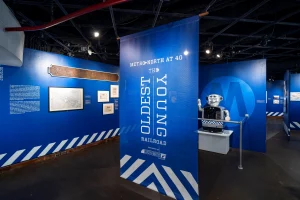Metro-North Railroad turned 40 this year, but its historical roots go back to the earliest days of New York’s transportation network. It took extraordinary teamwork, grit, and determination to forge Metro-North from its many disparate parts and to successfully operate it over these past four decades. Now on view at Grand Central Terminal, the New York Transit Museum’s new exhibit, Metro-North at 40: The Oldest Young Railroad, explores the first 40 years of the Metro-North’s success. Along the way, the exhibit celebrates the people who made it happen and looks to the future.
Metro-North at 40 traces the history of the second-busiest commuter rail in the United States all the way back to the early 19th century. The present-day lines that comprise Metro-North’s trackage are vestiges of some of the most important early American railroads, including the New York and Harlem Railroad, Hudson River Railroad, New York and New Haven Railroad, and Cornelius Vanderbilt’s New York Central and Hudson River Railroad. These rail routes spurred the development of suburban commuter towns that are today served by the Metro-North Railroad.
Visitors to the New York Transit Museum’s Grand Central Gallery can view early plans for rapid transit, railroad maps, authentic station signage, photography from the Transit Museum’s vast collections, and artifacts including the Metro-North’s 1980s mission statement and flipboard panels replaced by digital technology in the 2000s. Metro-North at 40 visitors will even get to meet Metro-Man II, a friendly robot that was sent into communities to teach children about railroad safety.
Metro-North at 40 is on view at the New York Transit Museum Gallery & Store at Grand Central Terminal. The Museum’s Gallery & Store are open Monday through Friday, 10am to 7:30pm; Saturday and Sunday, 10am to 6pm; and is closed on major holidays and for special events. It is located in the shuttle passage on 42nd Street and Park Avenue, adjacent to the Station Master’s Office, and is free to the public year-round. Plan your visit at nytransitmuseum.org/visit.

-via Press Release


